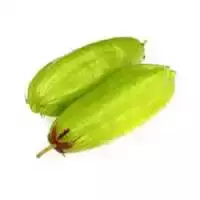Bilimby (cucumber tree)

Have you heard about a tree that bears fruit with cucumbers, and not at all those that grow in our beds, but exotic? It will probably be interesting for many to learn about bilimbi or cucumber tree.
This plant is not so simple, but why is it called cucumber? There are several reasons for this, the first of which is that bilimbi fruits are very similar in appearance to our cucumbers. The second is the similarity in the use of bilimbi (cucumber tree) - they can also be preserved by salting or pickling.
The islands of Indonesia are considered the birthplace of bilimbi (cucumber tree), however, as happens with other plants, the beauty of the plant could not help but interest the inhabitants of other tropical countries. Bilimbi (cucumber tree) can reach really huge sizes - up to nine meters in height, however, as a rule, its average height is about five meters.
In many ways, the bilimbi (cucumber tree) owes its attractive appearance to the arrangement of leaves that go exactly in a row, completely covering the branches. In addition, an incredibly mesmerizing sight opens at night, when the leaves of the bilimbi fold, creating the effect of a sleeping tree.
Bilimbi (cucumber tree) blooms directly from the trunk or from solid adult branches. Tiny fragrant flowers, which consist of five petals, usually appear in large numbers, and immediately after flowering, the tree covers green fruits, which are very similar to miniature cucumbers up to ten centimeters in size. The immature fruit of the bilimbi (cucumber tree) is painted bright green - it is very crispy. Ripe is distinguished by juicy pulp, sour taste.
It is worth noting that the fruit of bilimbi (cucumber tree) is useful and meaningful in terms of vitamin and mineral composition. The sour taste of the fruit allows you to combine it with a wide variety of dishes. For example, from the fruits of bilimbi (cucumber tree), seasoning is often made, which is later added to meat and fish dishes.
However, the fruit of bilimbi (cucumber tree) is good with meat alone - Costa Ricans serve it with beans and rice. In addition, mature fruits are used for preparing drinks, as well as canning. In some cities of Indonesia, the fruits of bilimbi (cucumber tree) are dried and stored in this form for further use in culinary affairs.
In medicine, bilimbi (cucumber tree) has also proven itself well. In particular, in the Philippine Islands, the leaves of this plant are applied in rheumatism and tumors. Fresh leaves of bilimbi (cucumber tree) are often used to treat sexually transmitted diseases. And for some countries, the leaves of this plant are an effective remedy for bites of poisonous animals and insects.
bilimbi (cucumber tree) 40 kCal
Energy value of bilimbi (cucumber tree) (Ratio of proteins, fats, carbohydrates - ju):
Proteins: 0.61 g (~ 2 kCal)
Fats: 0.3 g (~ 3 kCal)
Carbohydrates: 6g (~ 24kCal)
Energy ratio (bj | y): 6% | 7% | 60%
 Español
Español Français
Français Português
Português Русский
Русский 简体中文
简体中文 繁體中文
繁體中文 日本語
日本語 한국어
한국어 العربية
العربية Türkçe
Türkçe Қазақ
Қазақ Deutsch
Deutsch Italiano
Italiano Українська
Українська
